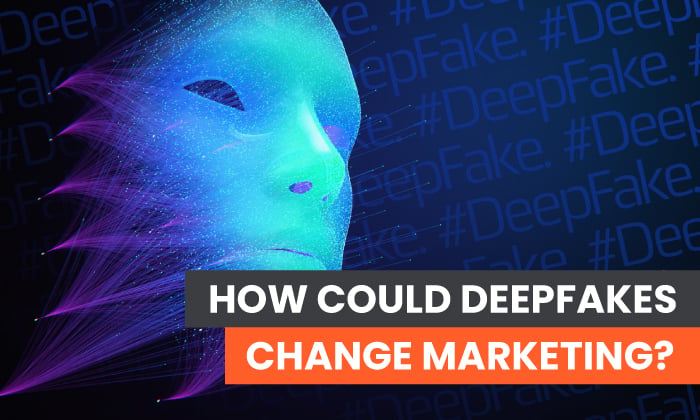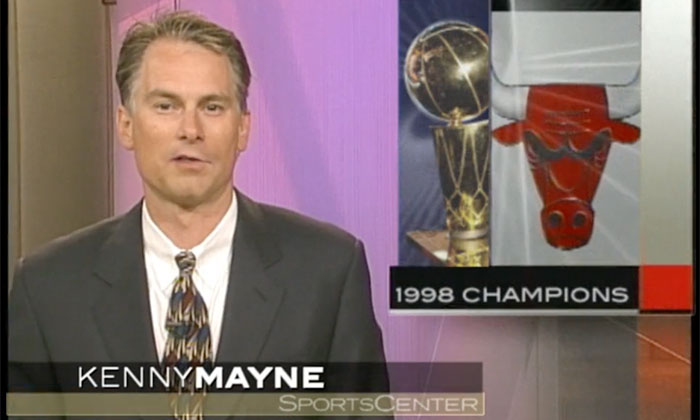
Deepfakes are receiving a lot of bad press.
U.S. Sen. Marco Rubio (R-Fla.) called the technology a propaganda weapon.
Facebook’s COO Sheryl Sandberg said deepfakes raise the issue of not believing what you see.
Investigative journalist Rana Ayyub was targeted with a deepfake pornography video to discredit and silence her.
With so much negativity around the tech, is there any chance of it bringing good into the world?
Yes! The possibilities when you combine AI technology with marketing are exciting and can change how we speak with our customers forever.
When used with positive intent, they are a potent marketing tool.
Below, I’m breaking down exactly what these videos are, the drawbacks of using them, and the different ways marketers are currently using deepfakes to create stronger campaigns.
What Are Deepfakes?

Have you seen a YouTube video of Barack Obama calling Donald Trump a “complete dipshit?” What about Jon Snow apologizing for the disastrous season finale of Game of Thrones?
If you answered yes, you’ve seen a deepfake video.
The term “deepfake” was coined in 2017 and is a combination of “deep learning” and “fakes.” It uses deep learning technology (a branch of machine learning) to create the dupe.
Artificial Intelligence (AI) learns what the source face looks like at different angles and then superimposes it onto an actor’s face, essentially creating a mask.
For example, let’s say you have a database of audio clips or video files of a person. You could create a hyper-realistic fake video of celebrities discussing the future of cinema or revenge porn.
Hollywood has already taken advantage of deepfakes by transposing real faces onto other actors. The most notable example is bringing Carrie Fisher back to life for a short scene in Rogue One: A Star Wars Story.
While many fear the technology being used for nefarious ends (more on this below), deepfakes offer a range of intriguing possibilities. You can create apps to try a new hairstyle or use it to help doctors with medical diagnosis.
The Drawbacks of Using Deepfake Technology
With the rise of deepfake technology, it’s not hard to understand why some people are skeptical and even terrified of it becoming widely adopted.
After all, the advances in this technology make it harder to distinguish what is real and fake.
It can lead to serious dangers like fake news, putting words in politicians’ or celebrities’ mouths, and ruining someone’s life with fake pornography.
Lack of Trust
Deepfakes can breed a culture of mistrust and not knowing what to trust. If the president holds a press conference inciting violence, but it’s a deepfake, how do you know what to believe?
For example, a deepfake of Mark Zuckerberg made the rounds on the internet. The video shows Facebook’s CEO giving a speech about how the platform “owns” its users and crediting an organization called Spectre for Facebook’s success.
Increase in Scams
Another con is the opportunity it provides for scammers. Audio deepfakes have already been used to defraud people out of money.
For example, a German energy firm’s U.K. subsidiary paid nearly $243,000 into a Hungarian bank account after a scammer mimicked the German CEO’s voice.
The core message for both examples is not knowing what is real.
Consumers are already doubting what they are reading online with social media sites like Facebook, Twitter, and Instagram, adding fact-checking processes to content. Deepfakes can create more distrust of everyone around us and make us question everything we are seeing and hearing.
7 Ways Marketers Can Use Deepfakes
With all the backlash and potential pitfalls of deepfake technology, can marketers use it for good?
The answer is yes!
Some of the world’s biggest brands are already experimenting with deepfakes and using them to create unique and engaging content.
As long as you’re transparent about using the technology, you can create a more dynamic consumer journey.
1. Dynamic Campaigns With Influencers to Increase Reach

Imagine having an influencer agree to an ad campaign and only provide you with 20 minutes of audio content and a few video shots.
No lengthy photo shoot or filming days required.
Not only does it help you save time, but it opens the door to creating dynamic campaigns, a.k.a. microtargeted ads at scale.
Case in point: David Beckham’s 2019 malaria awareness ad. The deepfake had the soccer star speaking in nine languages and is an excellent example of how this technology can increase a campaign’s reach.
Translating an ad into multiple languages also allows brands to enter new markets seamlessly and speak to consumers in their native tongue while still benefiting from the influencer or celebrity’s likeness.
2. Hyper-Personalized Campaigns for Your Audience
While some people want to ban deepfakes because of how they can be used to deceive people, it’s a creative and groundbreaking technology for marketers when used for good.
If you’re in the fashion industry, you could easily show models with different skin tones, heights, and weights.
With the average person seeing thousands of ads per day, using this tech to create psychological ownership and see the product as an extension of themselves is vital to cut through the noise.
It also helps marketers create hyper-personalized ads. The benefits of creating a shopping experience catered to multiple segments mean you can reap the rewards of personalized marketing.
3. Product Ownership to Increase Sales
Another way to create ownership with deepfakes is using the technology to create personalized videos of your clients using or wearing your products.
For example, Reface AI lets users virtually try on the new Gucci Ace sneaker as part of a virtual try-on haul. Users can browse through the footwear options and view it on foot by pointing the phone at their feet.
Savvy marketers know the likelihood of a sale increases if people feel like they own the product. It doubles down on the sensory experience where the longer someone spends looking and holding a product, the more likely they will buy it.
Deep learning can help stimulate the same experience with a deepfake of the customer behind the wheel of the latest BMW or a makeup look with the newest MAC eyeshadow palette.
4. Host Exhibitions and Events Anywhere in the World

For the events and art industries, deepfakes open up a world of exciting possibilities. The technology can help you recreate objects or people anywhere in the world at the same time.
An example is the Dalí Museum in St. Petersburg, Fla., which uses a deepfake of Salvador Dalí to greet guests. It creates a more engaging experience for visitors and brings the surrealism master back to life.
Dalí’s video was created by using over 6,000 frames of video footage from past interviews and 1,000 hours of machine learning to overlay it onto an actor’s face. What makes the deepfake even more impressive is that Dalí is interactive. The video has more than 190,000 possible combinations depending on a person’s answers.
While we already have holographic concerts for iconic musicians like Michael Jackson, deepfakes would create a more hyper-real experience for attendees. Art exhibitions can use the technology to display artworks around the world simultaneously.
Marketers can take it one step further and create deepfakes of products prelaunch (like the new iPhone) to generate buzz and create an interactive Steve Jobs to answer questions about the latest device.
5. Use Deepfakes to Entertain Your Audience

Marketers can use deep learning to create ad campaigns we would have never been able to do 20 years ago.
State Farm is leading the pack with its ad for The Last Dance, an ESPN documentary on Michael Jordan and the Chicago Bulls.
Using deepfake technology, State Farm superimposed 1998 SportsCenter footage to make it look like Kenny Mayne predicted the documentary.
The ad’s success led to a follow-up ad with Keith Olbermann and Linda Cohn “predicting” Phil Jackson’s success when he left Chicago to lead the Lakers.
These deepfakes serve to purely delight audiences and create a viral piece of content for the brand.
6. Market Segmentation and Personalization
One of the most successful deepfake examples using market segmentation is the 2018 Zalando campaign with Cara Delevingne.
The campaign’s concept was to create awareness around Zalando now delivering Top Shop fashion to people in the most remote parts of Europe.
With a single video shoot, they created 60,000 bespoke video messages for every tiny town and village in Europe using deepfake technology to produce alternative shots and voice fonts. Then using Facebook’s ad targeting, they showed users the specific video which mentioned their hometown.
The campaign received more than 180 million impressions, and Top Shop sales increased by 54 percent.
This can help marketers eliminate further customer generalizations or affinity grouping and create content that speaks to people on a more individual level.
7. Educating Consumers With Deepfakes
Do you have a product with a learning curve? You can use deepfake technology to educate your customers on how to use it and improve their skills.
For example, if you’re a camera brand like Canon, you can use an AI instructor to help novice photographers learn faster. The technology can point out compositional mistakes, advise on camera settings, and help them slowly master their device.
At trade shows, you could have potential customers practice taking photos, learning from the AI, or testing their skills against the deepfake. It can help create an interactive experience, put the product in the person’s hands, and start building brand loyalty.
Conclusion
Of course, there’s always going to be a few bad apples. While some people are causing mayhem with deepfakes, there are plenty of golden opportunities for marketers.
This technology allows you to create hyper-personalization, duplicate your marketing efforts instantly, increase brand loyalty, and use product ownership to increase sales.
What are your thoughts on using deepfakes in marketing? Do you think its potential to do good outweighs the bad?
from Blog – Neil Patel https://ift.tt/3wWyJDp

No comments:
Post a Comment